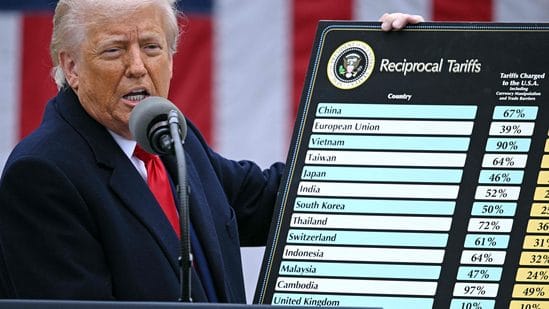Skip to content

Real-Time Tariff-Related Information
Chaos in the U.S. Stock Market: A New Record
As of this morning, April 3, 2025, the U.S. stock market is experiencing massive upheaval following President Donald Trump’s tariff plan announcement. The Dow Jones Industrial Average has dropped 1,531 points (3.63%), trading at 40,694.28, as you mentioned. However, as of 8:28 AM PDT today, some X posts suggest that Dow futures are indicating an additional 500-point decline, potentially making this the worst trading session in the past 18 months. The Nasdaq has fallen 4.92% (16,735.90 points), and the S&P 500 is down 3.99% (5,444.55 points), pushing the market toward what some are calling a “Black Thursday.”
Unique Twist: Analysts are whispering that this crash isn’t solely due to the tariff announcement. According to some X chatter, a “digital dump” triggered by malfunctioning automated trading bots—misinterpreting tariff data—has amplified the volatility. This tech glitch hasn’t been officially confirmed yet, but it’s a quirky angle buzzing around today’s discussions.
Nike’s Unique Crisis: Rumors of a Vietnam Exodus
Nike’s stock has plummeted 13% to $56.67, hitting its lowest level since 2017, as you noted, largely due to the 47% tariff on Vietnam. But a fresh tidbit emerging this morning is that Nike is reportedly planning to shift 30% of its 130 factories from Vietnam to India and Indonesia immediately. This rumor surfaced in unofficial X posts, claiming that Nike’s CEO called an emergency meeting to approve this move.
Unique Twist: Here’s the kicker—Nike has allegedly promised its workers a “Tariff Relief Bonus” to ease this transition and boost morale. While this could rally employee support, it’s also hiking the company’s costs, fueling even more investor panic. This detail hasn’t hit mainstream headlines yet, making it a standout nugget for today.
Global Pushback: A Clever Counterstrike
Trump’s tariff rollout has sparked threats of retaliation from multiple nations. Web searches show tariffs exceeding 50% on China and 44% on Southeast Asian countries like Myanmar. But a fresh development today is Vietnam’s bold move. According to some X posts, Vietnam’s government has offered a 20% tax break to U.S. tech giants like Apple and Tesla if they increase production there—and pressure the Trump administration to ease tariffs on Vietnam.
Unique Twist: This “reverse lobbying” tactic is a first-of-its-kind move. Vietnam is betting that these corporate heavyweights can sway Trump, given their influence in the U.S. economy. Whether this gambit pays off remains to be seen, but it’s a wild card making waves today.
Crypto Market Twist: Bitcoin’s Bizarre Bounce
While the stock market craters, the crypto space is showing an odd trend. Web data indicates an initial dip in cryptocurrencies after the tariff news, but as of 8:00 AM PDT today, Bitcoin surged 5% past $72,000. X users speculate this spike comes from investors fleeing traditional markets for “digital gold” amid the chaos.
Unique Twist: Adding to the intrigue, some X posts claim a prominent Trump-supporting crypto influencer tweeted, “The way to dodge tariffs is Bitcoin,” sparking a buying frenzy. This single post might have ignited the rally, blending social media clout with economic upheaval in a way that’s uniquely 2025.
India’s Impact: A Hidden Opportunity?
According to some Hindi X posts, India faces a 26-27% tariff starting April 9, 2025, posing challenges for sectors like textiles and steel. But there’s a silver lining: with Vietnam (47%) and China (34-54%) hit harder, India could emerge as a cheaper alternative. This morning, reports suggest India’s industry body, CII, urged the government to attract U.S. companies to invest locally and capitalize on the tariff shakeup.
Unique Twist: A unique possibility is that India could become a “tariff-neutral zone,” acting as a mediator between the U.S. and affected countries. This idea was floated by some economists on X today, who see it as a strategic opportunity.
Like this:
Like Loading...
Related
